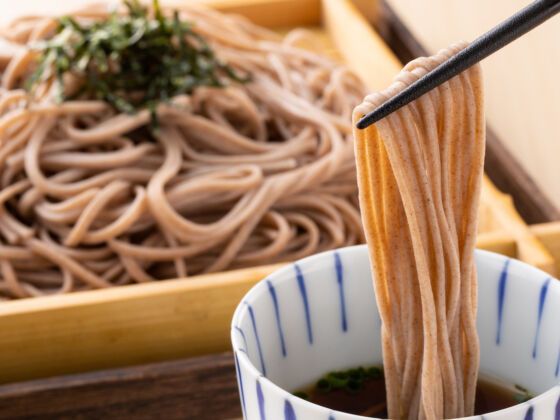In the United States, a quick meal at a bar typically starts with a beer, cocktail, or glass of wine and a small appetizer. The ritual has no name, formal or otherwise, though a cocktail-minded or worldly person in your group may insist on calling the drink an aperitif. These before-dinner rituals are a little more specific in Japanese soba restaurants. The pre-meal drink and snack is called soba-mae, and it’s an important part of any soba eating experience.

To Fully Enjoy Japanese Soba Noodles, Partake in Soba-Mae
Soba-mae translates literally to “before soba.” Today, you can find a variety of drinks served during the soba-mae portion of the meal, from sake to whisky highballs. Nori, a type of dried seaweed, is an always welcome snack, though which small bites are served depends on where you’re eating. Soba-mae is a tradition that’s continued with rising and falling popularity for centuries.
Soba means buckwheat. Researchers believe buckwheat was originally domesticated in Yunnan Province, China, and made it to the Korean peninsula and then Japan. The first written record of buckwheat in Japan dates to the eighth century when it was cultivated in between the growing seasons of other crops, while the first written record of sobagiri (which translates to cut soba) appeared in the mid-1500s. Buckwheat is hardy and easy to grow, making it the perfect choice for a catch-crop grown in tough soil or during droughts, according to Japan Times.
In the modern era, most soba noodles are noodles made from buckwheat flour — buckwheat lacks gluten because it’s a seed rather than a wheat or grain, so the noodles are typically formed with the addition of wheat flour or another binder.
The Edo Period between the early 1600s and mid-1800s saw a rise in the popularity of soba noodles. Ni-hachi soba, made with 80 percent soba flour and 20 percent wheat flour, was popular at the time because that combination made the noodles easier to prepare, and it’s still the preferred ratio for many producers.
At the time, soba was served fresh, but diners had to wait while the noodles were prepared. Drinks and snacks were served to pass the time and prepare eaters’ taste buds for the flavors of the soba that they were waiting for. Sake, kamaboko (seafood), and tamagoyaki (a rolled omelet) were popular choices, according to the Japanese soba restaurant and shop Kamaboko. Thus, the soba-mae tradition was born.
The regions that were once famous for buckwheat — Nagano Prefecture and Hokkaido — are still well known for the crop and responsible for most of the domestic production, though the vast majority of buckwheat used in Japan is imported from China, the US, and Canada. Soba’s popularity waxed and waned over the centuries, but it’s once again on the rise and bringing the tradition of soba mae along with it. Today, there are some 24,000 soba restaurants in Japan, according to Discover Japan.
Your selection of soba-mae options varies. There are of course nori and traditional kamaboko snacks served alongside sake. Relatively modern drinks have fallen into the fold of soba-mae, as well, such as the whisky highball. During a virtual soba making class with cookbook author and instructor Sonoko Sakai, highballs made with Suntory’s Toki Japanese whisky were the drink of choice. The highball — typically made with one part whisky to three parts soda water — became a popular bar drink in the 2000s, House of Suntory brand ambassador Jonathan Armstrong says, because it’s the perfect informal after-work drink.
Regardless of what you choose to drink and snack on before your bowl of soba arrives, embrace the selection of small bites beforehand. Your soba will simply feel more complete with the addition of soba-mae.